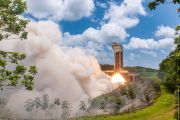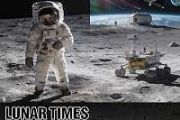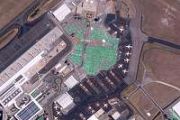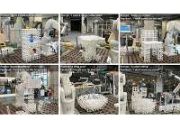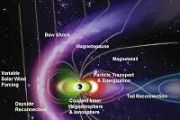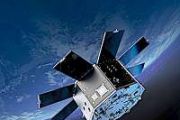
Copernical Team
Northrop Grumman Selects Viasat for Defense Space Internet Integration Project
 In a significant development for military satellite communications, Viasat, Inc. (NASDAQ: VSAT) has secured a contract from Northrop Grumman to participate in a pioneering U.S. Air Force Research Laboratory (AFRL) initiative.
The initiative, known as the Defense Experimentation Using Commercial Space Internet (DEUCSI) Call 003 program, or more colloquially as 'Global Lightning,' aims to ex
In a significant development for military satellite communications, Viasat, Inc. (NASDAQ: VSAT) has secured a contract from Northrop Grumman to participate in a pioneering U.S. Air Force Research Laboratory (AFRL) initiative.
The initiative, known as the Defense Experimentation Using Commercial Space Internet (DEUCSI) Call 003 program, or more colloquially as 'Global Lightning,' aims to ex Military Leaders Say Maintaining U.S. Strategic Edge Requires Continued Investment
 Senior military officials told lawmakers today that the United States remains ready to deter strategic and space-based threats, but continued investment is critical amid increasing competition.
Air Force Gen. Anthony J. Cotton, U.S. Strategic Command commander, and Space Force Gen. Stephen N. Whiting, U.S. Space Command commander, said recent investments by Russia and China underscore the
Senior military officials told lawmakers today that the United States remains ready to deter strategic and space-based threats, but continued investment is critical amid increasing competition.
Air Force Gen. Anthony J. Cotton, U.S. Strategic Command commander, and Space Force Gen. Stephen N. Whiting, U.S. Space Command commander, said recent investments by Russia and China underscore the Iran launches imaging satellite from Russia
 Iran announced on Thursday the launch of a remote sensing and imaging satellite into orbit from Russia, according to state media.
The launch of "Pars-I" with the Russian Soyuz-2.1b launcher was broadcast live by state television in Iran.
The satellite was launched "from Russia's Vostochny launch base", some 8,000 kilometres (5,000 miles) east of Moscow, according to the official IRNA new
Iran announced on Thursday the launch of a remote sensing and imaging satellite into orbit from Russia, according to state media.
The launch of "Pars-I" with the Russian Soyuz-2.1b launcher was broadcast live by state television in Iran.
The satellite was launched "from Russia's Vostochny launch base", some 8,000 kilometres (5,000 miles) east of Moscow, according to the official IRNA new NASA largely satisfied with Intuitive Machines lunar deliveries despite 'challenges'
 In a significant milestone for lunar exploration, NASA has once again left its mark on the Moon, facilitated by the historic landing of Intuitive Machines' Nova-C lander, Odysseus. This event, occurring on February 22, 2024, not only underscores the evolving landscape of space exploration partnerships but also represents the resilience and innovative spirit driving the new era of lunar explorati
In a significant milestone for lunar exploration, NASA has once again left its mark on the Moon, facilitated by the historic landing of Intuitive Machines' Nova-C lander, Odysseus. This event, occurring on February 22, 2024, not only underscores the evolving landscape of space exploration partnerships but also represents the resilience and innovative spirit driving the new era of lunar explorati SpaceX launches new crew to ISS
 Three American astronauts and a Russian cosmonaut blasted off Sunday night from Florida for a six-month mission on the International Space Station.
The SpaceX Falcon 9 rocket lifted off at 10:53 pm (0353 GMT Monday) from the Kennedy Space Center, lighting up the night sky with a long, bright plume of orange flame.
Just minutes after the launch, as the rocket soared over the Atlantic, it
Three American astronauts and a Russian cosmonaut blasted off Sunday night from Florida for a six-month mission on the International Space Station.
The SpaceX Falcon 9 rocket lifted off at 10:53 pm (0353 GMT Monday) from the Kennedy Space Center, lighting up the night sky with a long, bright plume of orange flame.
Just minutes after the launch, as the rocket soared over the Atlantic, it World resource extraction could surge 60% by 2060, UN warns
 Extraction of Earth's natural resources could surge 60 percent by 2060, imperilling climate goals and economic prosperity, the UN said Friday, calling for dramatic changes in energy, food, transport and housing.
Enormous expansion of infrastructure, energy demand and consumer consumption over the last half century, particularly in wealthier countries, has driven a tripling of the world's us
Extraction of Earth's natural resources could surge 60 percent by 2060, imperilling climate goals and economic prosperity, the UN said Friday, calling for dramatic changes in energy, food, transport and housing.
Enormous expansion of infrastructure, energy demand and consumer consumption over the last half century, particularly in wealthier countries, has driven a tripling of the world's us Musk sues OpenAI over 'betrayal' of mission
 Elon Musk has launched a legal case against OpenAI, the AI firm he helped to set up in 2015, accusing its leaders of a "betrayal" of its founding mission.
The tycoon, who left OpenAI in 2018, argued in documents filed in a San Francisco court late Thursday that the firm was always intended as a nonprofit entity.
But he said recent boardroom changes meant OpenAI was now effectively a subs
Elon Musk has launched a legal case against OpenAI, the AI firm he helped to set up in 2015, accusing its leaders of a "betrayal" of its founding mission.
The tycoon, who left OpenAI in 2018, argued in documents filed in a San Francisco court late Thursday that the firm was always intended as a nonprofit entity.
But he said recent boardroom changes meant OpenAI was now effectively a subs SpaceX launch taking crew to ISS delayed again by weather
 A planned launch on Saturday of a mission to take three American astronauts and a Russian cosmonaut to the International Space Station was scrubbed due to poor weather.
SpaceX announced that the launch was delayed, and NASA said the agency would now target Sunday at 10:53 pm (0353 GMT Monday) for liftoff.
The SpaceX Crew Dragon named Endeavour is to carry the four atop a Falcon 9 rocket
A planned launch on Saturday of a mission to take three American astronauts and a Russian cosmonaut to the International Space Station was scrubbed due to poor weather.
SpaceX announced that the launch was delayed, and NASA said the agency would now target Sunday at 10:53 pm (0353 GMT Monday) for liftoff.
The SpaceX Crew Dragon named Endeavour is to carry the four atop a Falcon 9 rocket SpaceX set to launch new crew to ISS
 Three American astronauts and a Russian cosmonaut are due to blast off Sunday night from Florida for a six-month mission on the International Space Station.
After an attempt was called off Saturday night due to strong winds, the SpaceX Falcon 9 rocket is due to lift the travelers into orbit at 10:53 pm (0353 GMT Monday) from the Kennedy Space Center.
If forced to abort before launch agai
Three American astronauts and a Russian cosmonaut are due to blast off Sunday night from Florida for a six-month mission on the International Space Station.
After an attempt was called off Saturday night due to strong winds, the SpaceX Falcon 9 rocket is due to lift the travelers into orbit at 10:53 pm (0353 GMT Monday) from the Kennedy Space Center.
If forced to abort before launch agai Tiangong Space Station's Solar Wings Restored After Spacewalk Repair by Shenzhou XVII Team
 The crew of Shenzhou XVII has marked a significant milestone in the history of China's manned space exploration by successfully completing their second spacewalk outside the Tiangong space station. This recent EVA, conducted on Saturday, was particularly noteworthy as it included the first repair operation performed in space by Chinese astronauts, a statement from the China Manned Space Agency c
The crew of Shenzhou XVII has marked a significant milestone in the history of China's manned space exploration by successfully completing their second spacewalk outside the Tiangong space station. This recent EVA, conducted on Saturday, was particularly noteworthy as it included the first repair operation performed in space by Chinese astronauts, a statement from the China Manned Space Agency c 












